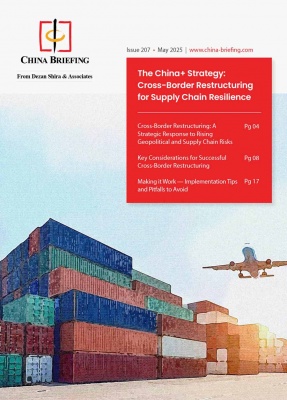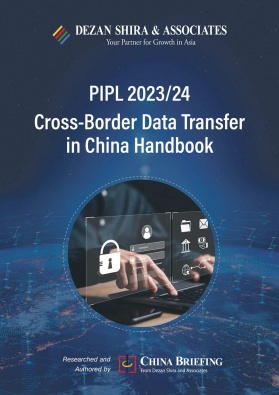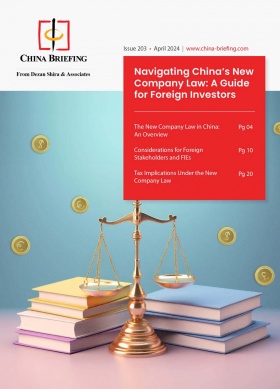Tax Audit in China: A Complete Guide
Tax audits in China have evolved significantly, characterized by expanded scope, technology-driven precision, and strengthened international cooperation. Businesses can mitigate risks by improving financial management, increasing legal awareness, actively cooperating with tax authorities, and seeking professional assistance as needed.
Tax audit, or tax inspection, refers to the examination and processing activities conducted by tax authorities in accordance with the law regarding the tax-related situations of taxpayers or withholding agents. It is an essential component of tax administration, aimed at ensuring the correct implementation of tax laws and accurate collection of national revenue.
In this article, we provide a comprehensive guide to tax audits in China. We introduce the typical processes, navigate recent trends, and offer practical case studies.
Objective of tax audit in China
Understanding the objectives of tax audits can help taxpayers avoid audit risks and develop effective strategies if they do become subject to a tax audit. The key objectives of tax audits include the following:
- Ensuring compliance with tax laws, regulations, and systems: This involves verifying that taxpayers and withholding agents adhere to tax law provisions and fulfill their tax obligations.
- Validating the legality of taxpayers’ business operations and tax-related activities: Tax audits aim to prevent and combat illegal practices, such as tax evasion, tax avoidance, and underreporting.
- Safeguarding tax revenue: Through audit processes, tax authorities ensure timely and accurate collection of national taxes.
General processes of a tax audit
The tax audit process generally includes four stages:
- Case selection: Audit agencies acquire case information through various channels and reasonably select audit targets. Methods for case selection include manual selection, computer-based selection, and reporting.
- Audit implementation: Tax personnel conduct on-site inspections or other forms of investigation, examining taxpayers’ records over several years and focusing on aspects such as contracts, invoices, upstream and downstream transactions, and cash flow.
- Review and examination: Analyzing and determining the audit results, ultimately producing a “Review Report (《审理报告》)” and a “Tax Processing Decision(《税务处理决定书》)” or a “Tax Audit Conclusion (《税务稽查结论》)”.
- Execution: Based on the adjudication results, appropriate measures are taken, such as recovering taxes, imposing fines, or using other legal means.
Recent trends of tax audit in China
In recent years, tax audit work in China has exhibited several notable trends:
- Technology-driven precision: With the expected rollout of the “Golden Tax Phase IV” system, tax authorities can integrate data from various departments, including invoices, banking information, business records, and customs data. This integration allows for more accurate identification of potential tax risks. Real-time monitoring of companies’ operations and tax behavior enables timely alerts and interventions for potential tax violations. It also means tax audits will be more targeted and to some extent, more easily triggered.
- Expanded audit scope: Tax audits now extend beyond routine business operations to cover areas such as individual income tax (IIT) and emerging fields like online streaming. There is a significant increase in audit efforts targeting offenses like false invoicing, conversion of public funds to private use, and fraudulent export tax refunds.
- Historical retrospection and in-depth audits: Tax authorities are now examining the historical tax situations of companies, conducting thorough investigations into long-standing unresolved tax issues. This approach not only combats persistent tax violations but also serves as a deterrent.
- Strengthened international cooperation: In the context of globalization, international collaboration in tax audits has intensified. Cooperation between Chinese tax authorities and counterparts in other countries and regions helps combat cross-border tax violations, profit shifting, and tax evasion and maintains international tax order.
Key matters subject to tax audit
In general, certain matters tend to be more frequently exposed to tax audits than others:
- False invoicing: False invoicing is a common illegal practice among businesses. Tax authorities identify and penalize such violations through precise analysis of clues.
- Public-to-private transactions and unusual funds: Frequent public-to-private and private-to-private transactions receive focused monitoring, especially when involving large sums of money.
- Improper use of tax incentives: When companies utilize tax incentives to reduce their tax burden, they must ensure legal compliance and avoid abusing these policies.
- IIT: The scrutiny of individual income tax has intensified, particularly concerning aspects like salary payments and income from online streaming.
- Industry-specific issues: Sectors such as pharmaceuticals, recycling, and agriculture face audit focus related to invoice management and pre-tax deductions.
- Abnormal tax burden: Both excessively high and excessively low corporate tax burdens may attract attention from tax authorities. For example, the tax scale of high-tech enterprises is closely scrutinized, especially when the additional deduction policy for research and development expenses is unreasonably used. Companies should maintain a tax burden reasonable to its scale.
Other matters with higher risks of tax audit include merger and acquisition transactions, asset transfers, export tax refunds, etc.
Consequences of tax audit
Tax audits pose extra risks to businesses, affecting not only their finances but may also negatively affect their reputation and normal operations. On some occasions, unexpected legal consequences may arise.
Below we list some potential consequences of being involved in tax audits:
- Payment of back taxes and fines: If a company has issues during tax declaration, such as underreporting or misreporting taxes, a tax audit will require them to refile and pay any outstanding taxes. Additionally, according to tax regulations, companies may face fines, directly increasing their financial burden.
- Resource drain: Businesses need to allocate significant human, material, and financial resources to cooperate with tax audits and handle tax-related documentation. This not only wastes resources but may also disrupt normal production and operations, further straining the company financially.
- Credit rating downgrade: Once identified for non-compliance, a company’s credit rating can be affected, potentially lowering its credibility for financing and partnerships.
- Damage to reputation: Issues revealed during tax audits may attract media and public attention, harming the company’s social reputation and impacting its brand image and market position.
- Operational disruption: Tax audits require companies to provide relevant information, consuming significant time and effort, which can adversely affect day-to-day operations.
- Uncovering hidden issues: Tax audits may reveal underlying problems and risks within the company, such as poor financial management or internal control deficiencies, necessitating additional resources for rectification.
- Administrative penalties: For violations discovered during tax audits, authorities may impose administrative penalties, including fines and confiscation of illegal gains.
- Criminal liability: In severe cases, companies and their responsible individuals may face criminal charges, such as tax evasion or issuing fraudulent VAT invoices, resulting in more serious consequences.
Suggestions to businesses to prevent tax audit risks
To reduce the risks and burdens associated with tax audits, we have the below suggestions for businesses:
- Strengthen financial management: Establish robust financial management systems to ensure accurate and compliant tax reporting.
- Enhance legal awareness: Provide training on tax regulations to increase employees’ legal awareness and compliance with tax laws.
- Cooperate actively with audits: During tax audits, companies should actively cooperate with tax authorities, providing truthful and complete information.
- Seek professional assistance: For complex tax issues, businesses can seek help from professional tax consulting firms to mitigate tax risks.
Case studies
Case 1: False invoicing
Between October 2022 and October 2023, XX Technology Co., Ltd. issued 63 value-added tax (VAT) invoices for technical service fees to downstream companies, totaling an amount of RMB 4,119,000.00. However, a tax investigation revealed that XX Company had no actual financial transactions with the downstream enterprises, and its employees were not involved in the related technical services. As a result, it was determined that XX Company lacked software development and technical service capabilities, violating relevant provisions of the Invoice Management Regulations. Consequently, the company was fined RMB 80,000.00.
In recent years, Chinese tax authorities have intensified inspections of large consulting fees, technical service fee invoices, and other related matters in the modern service industry. Some companies have been targeted due to suspected fictitious service projects, issuing false invoices, unfair pricing, cost allocation, and profit shifting. Enterprises must strictly adhere to national tax laws and regulations, ensuring that invoice issuance aligns with actual business operations and retaining relevant documentation.
Additionally, for enterprises engaged in goods sales, taxpayers should proactively self-monitor and ensure consistency and transparency in the following aspects:
- Goods flow: Verify whether goods exist in reality, whether production and transaction volumes match invoice data, and whether subsequent transportation handling is genuine.
- Invoice flow: Confirm that the number of invoices issued by the enterprise aligns with actual operations. Ensure consistency between raw material consumption, production volume, and sales volume.
- Fund flow: Regardless of how funds circulate, track whether the principal returns to sensitive accounts.
Case 2: High-income and high-net-worth individuals
A senior executive of a restaurant management company in Chengdu, Sichuan Province failed to complete the annual IIT settlement and payment as required. Despite multiple reminders and urging from the tax authorities, the executive refused to rectify the situation. Consequently, the Chengdu Municipal Tax Bureau’s First Inspection Bureau initiated an investigation, transferred the case to the court’s enforcement office, and implemented coercive measures. These measures included freezing bank accounts and electronic payment accounts, issuing a consumption restriction order, and recovering the tax arrears along with additional late fees. The executive was fined RMB 350,000.
Taxpayers should truthfully declare their IIT, comply with the law regarding annual IIT settlement and payment, and refrain from falsely claiming special additional deductions. It is crucial to take seriously the reminders and prompts from tax authorities to avoid legal consequences
Case 3: Verification of additional deductions for R&D expenses
In February 2023, the Chaoyang District Tax Bureau of Beijing Municipal City identified discrepancies in M Technology Co., Ltd.’s utilization of preferential policies related to additional deductions for R&D expenses. M Technology is a limited liability company with qualifications as a high and new technology enterprise, primarily engaged in computer software development and sales. Despite the company’s industry recognition and eligibility for R&D expense deductions, tax authorities analyzing its tax data noticed anomalies. Specifically, the company’s low-income tax contribution rate and significant fluctuations in operating revenue—profitable in 2019, substantial losses in 2020, and profitability again in 2021—raised concerns. Additionally, the high proportion of equipment costs and R&D personnel salaries prompted further scrutiny.
Initial investigation:
The financial manager, Mr. Wei, was interviewed, and the tax authorities requested documentation for R&D expense deductions from 2019 to 2021. Mr. Wei explained that the company’s focus on R&D led to higher R&D personnel salaries. During the investigation, an undeclared outsourced R&D project was discovered. The company claimed to be rectifying the situation, but tax authorities pointed out that this project did not meet the criteria for enjoying preferential policies and should increase the taxable income. Further discrepancies were found in the documentation, including inconsistencies between creation dates and image timestamps. The company attributed this to using concept design graphics for future applications.
In-depth examination:
The investigation team interviewed the technical director, Mr. Li, and Mr. Wei. Mr. Li explained that some projects were outsourced due to cost considerations. Tax authorities identified a misunderstanding of tax policies by Mr. Li. Certain software features related to information push notifications did not substantially improve, rendering them ineligible for additional deductions. Furthermore, the undeclared outsourced R&D project did not meet the criteria for enjoying the benefits.
Case outcome:
M Technology was found to have improperly deducted and excessively claimed R&D expenses, along with inaccurate allocation of R&D personnel and equipment costs. As a result, the Chaoyang District Tax Bureau required M Technology to conduct a self-audit and adjust the irregularly deducted amount of RMB 87.75 million. The company also adjusted its corporate income tax declarations for 2019-2021, resulting in a payment of RMB 13.8376 million in taxes and RMB 1.6245 million in late fees. M Technology complied with the self-audit and made the necessary tax payments
|
Key Points for Tax Deduction Verification Related to Additional Deductions |
|
| Items | Details |
| Verify the industry of the enterprise | Industries not eligible for pre-tax additional deductions include tobacco manufacturing, accommodation and catering, wholesale and retail, real estate, leasing and business services, entertainment, and other industries specified by the Ministry of Finance and the State Administration of Taxation. |
| Check disallowed pre-tax deductible expenses | Examine R&D expenses to ensure they do not include accrued expenses, deferred expenses, or expenses without valid supporting documents, which are not allowed to be deducted pre-tax. |
| Verify R&D activities | Certain activities are not eligible for pre-tax additional deductions:
|
| Check R&D expense collection | Specific aspects of R&D expenses include personnel labor costs, direct input costs, depreciation, and long-term deferred expenses. |
| Verify outsourced R&D projects | Check whether the contractor is an individual and has valid supporting documents (especially invoices). If there is an affiliated relationship, the contractor must provide detailed expense breakdown for R&D projects. Apply the arm’s length principle to determine related-party R&D expenses. |
| Check capitalization projects | Confirm whether development-stage expenses meet capitalization criteria and whether they are included in R&D cost deductions. If eligible, consider additional deductions before capitalizing intangible assets.
For R&D activities resulting in intangible assets, verify whether the intangible assets eligible for additional amortization comply with policy-defined collection criteria and whether the timing of intangible asset recognition is correct. |
| Handle special cases of R&D expense offset | Confirm whether special income (e.g., scrap materials, defective products, intermediate prototypes) reduces deductible R&D expenses.
Check whether directly developed products or components sold externally offset deductible R&D expenses. Address government subsidies used for R&D, considering direct offset of R&D expenses in accounting (if not confirmed as taxable income by tax authorities). |
About Us
China Briefing is one of five regional Asia Briefing publications, supported by Dezan Shira & Associates. For a complimentary subscription to China Briefing’s content products, please click here.
Dezan Shira & Associates assists foreign investors into China and has done so since 1992 through offices in Beijing, Tianjin, Dalian, Qingdao, Shanghai, Hangzhou, Ningbo, Suzhou, Guangzhou, Haikou, Zhongshan, Shenzhen, and Hong Kong. We also have offices in Vietnam, Indonesia, Singapore, United States, Germany, Italy, India, and Dubai (UAE) and partner firms assisting foreign investors in The Philippines, Malaysia, Thailand, Bangladesh, and Australia. For assistance in China, please contact the firm at china@dezshira.com or visit our website at www.dezshira.com.
- Previous Article China’s Third Plenum: What to Watch for Foreign Investors
- Next Article China’s Regulatory Adjustments to Unlock Service Sector Potential in Six Cities
























